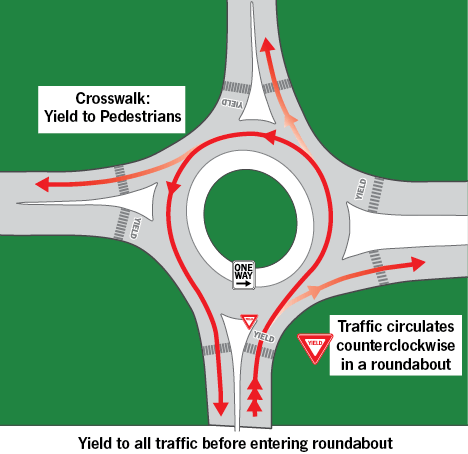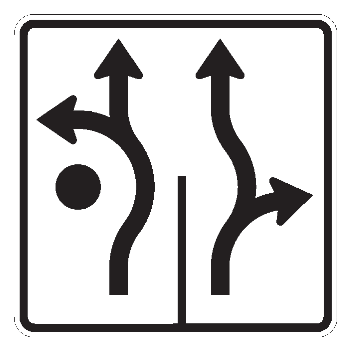12- Roundabouts
 Recommended minimum instructional time: 2 hours
Recommended minimum instructional time: 2 hours
Goal: Teach your teen to maneuver safely in and out of roundabouts.
Location: Start with a single lane roundabout and move onto multi-lane roundabouts when appropriate.

This example shows the traffic movement patterns through a one-lane roundabout. The one-lane roundabout is known as one of the safest and most efficient intersections.
Roundabouts are becoming more common in the United States because they provide safer and more efficient traffic flow than standard intersections. Statistics for roundabouts have found reductions in injury crashes of 72–80 percent and reductions in all crashes of 35–47 percent when compared to other types of intersections.
When driving a roundabout, the same general rules apply as for maneuvering through any other type of intersection.
☐ Skill one – approaching a roundabout
- Slow down. Obey traffic signs and pavement markings which direct you into the correct lane before entering.
- Yield to vulnerable roadway users before during and after traveling in roundabout.
-
As you approach the yield line, look to your left.
-
Vehicles in the roundabout have the right of way.
-
Enter the roundabout when there is an appropriate gap in traffic. Merge with the flow of other vehicles.
-
Never make a left turn to enter a roundabout.
☐ Skill two – driving in a roundabout
- Stay to the right of the center island.
- Avoid stopping and changing lanes.
- Exit the roundabout at nearest exit and pull over for emergency vehicles.
- Refrain from passing and give special consideration to large vehicles. Do not drive next to them as they may need to use more than one lane of the roundabout.
☐ Skill three – exiting a roundabout
- Maintain a slow speed. If you miss your exit, drive around the roundabout to your exit again.
- Use your turn signal when exiting.
- Do not accelerate until you are past the pedestrian crossing.
☐ Skill four – two or more lane roundabouts
- In a multi-lane roundabout, if you want to make a right turn, you should be in the right lane or other lanes that are signed and marked as right turn lanes.
- If you want to go straight, observe the signs and arrows to see which lane is correct.
